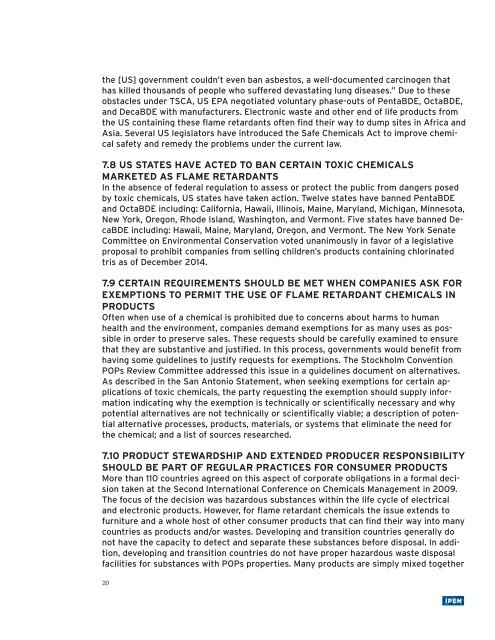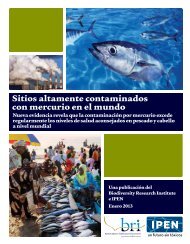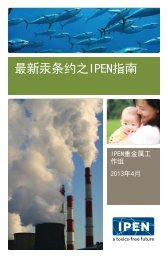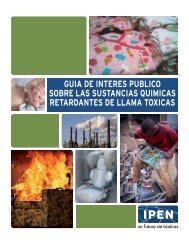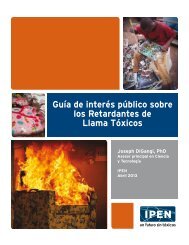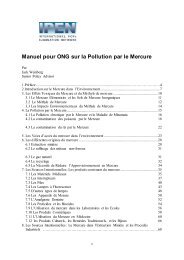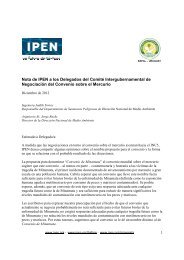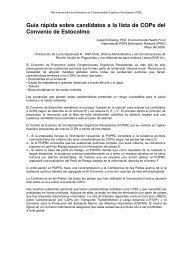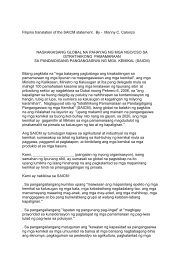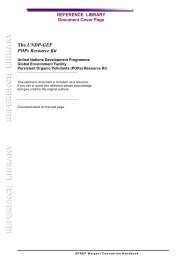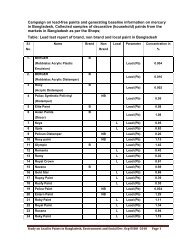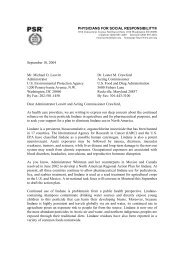A Public Interest Guide to Toxic Flame Retardant Chemicals
A Public Interest Guide to Toxic Flame Retardant Chemicals
A Public Interest Guide to Toxic Flame Retardant Chemicals
Create successful ePaper yourself
Turn your PDF publications into a flip-book with our unique Google optimized e-Paper software.
the [US] government couldn’t even ban asbes<strong>to</strong>s, a well-documented carcinogen that<br />
has killed thousands of people who suffered devastating lung diseases.” Due <strong>to</strong> these<br />
obstacles under TSCA, US EPA negotiated voluntary phase-outs of PentaBDE, OctaBDE,<br />
and DecaBDE with manufacturers. Electronic waste and other end of life products from<br />
the US containing these flame retardants often find their way <strong>to</strong> dump sites in Africa and<br />
Asia. Several US legisla<strong>to</strong>rs have introduced the Safe <strong>Chemicals</strong> Act <strong>to</strong> improve chemical<br />
safety and remedy the problems under the current law.<br />
7.8 US STATES HAVE ACTED TO BAN CERTAIN TOXIC CHEMICALS<br />
MARKETED AS FLAME RETARDANTS<br />
In the absence of federal regulation <strong>to</strong> assess or protect the public from dangers posed<br />
by <strong>to</strong>xic chemicals, US states have taken action. Twelve states have banned PentaBDE<br />
and OctaBDE including: California, Hawaii, Illinois, Maine, Maryland, Michigan, Minnesota,<br />
New York, Oregon, Rhode Island, Washing<strong>to</strong>n, and Vermont. Five states have banned DecaBDE<br />
including: Hawaii, Maine, Maryland, Oregon, and Vermont. The New York Senate<br />
Committee on Environmental Conservation voted unanimously in favor of a legislative<br />
proposal <strong>to</strong> prohibit companies from selling children’s products containing chlorinated<br />
tris as of December 2014.<br />
7.9 CERTAIN REQUIREMENTS SHOULD BE MET WHEN COMPANIES ASK FOR<br />
EXEMPTIONS TO PERMIT THE USE OF FLAME RETARDANT CHEMICALS IN<br />
PRODUCTS<br />
Often when use of a chemical is prohibited due <strong>to</strong> concerns about harms <strong>to</strong> human<br />
health and the environment, companies demand exemptions for as many uses as possible<br />
in order <strong>to</strong> preserve sales. These requests should be carefully examined <strong>to</strong> ensure<br />
that they are substantive and justified. In this process, governments would benefit from<br />
having some guidelines <strong>to</strong> justify requests for exemptions. The S<strong>to</strong>ckholm Convention<br />
POPs Review Committee addressed this issue in a guidelines document on alternatives.<br />
As described in the San An<strong>to</strong>nio Statement, when seeking exemptions for certain applications<br />
of <strong>to</strong>xic chemicals, the party requesting the exemption should supply information<br />
indicating why the exemption is technically or scientifically necessary and why<br />
potential alternatives are not technically or scientifically viable; a description of potential<br />
alternative processes, products, materials, or systems that eliminate the need for<br />
the chemical; and a list of sources researched.<br />
7.10 PRODUCT STEWARDSHIP AND EXTENDED PRODUCER RESPONSIBILITY<br />
SHOULD BE PART OF REGULAR PRACTICES FOR CONSUMER PRODUCTS<br />
More than 110 countries agreed on this aspect of corporate obligations in a formal decision<br />
taken at the Second International Conference on <strong>Chemicals</strong> Management in 2009.<br />
The focus of the decision was hazardous substances within the life cycle of electrical<br />
and electronic products. However, for flame retardant chemicals the issue extends <strong>to</strong><br />
furniture and a whole host of other consumer products that can find their way in<strong>to</strong> many<br />
countries as products and/or wastes. Developing and transition countries generally do<br />
not have the capacity <strong>to</strong> detect and separate these substances before disposal. In addition,<br />
developing and transition countries do not have proper hazardous waste disposal<br />
facilities for substances with POPs properties. Many products are simply mixed <strong>to</strong>gether<br />
20


